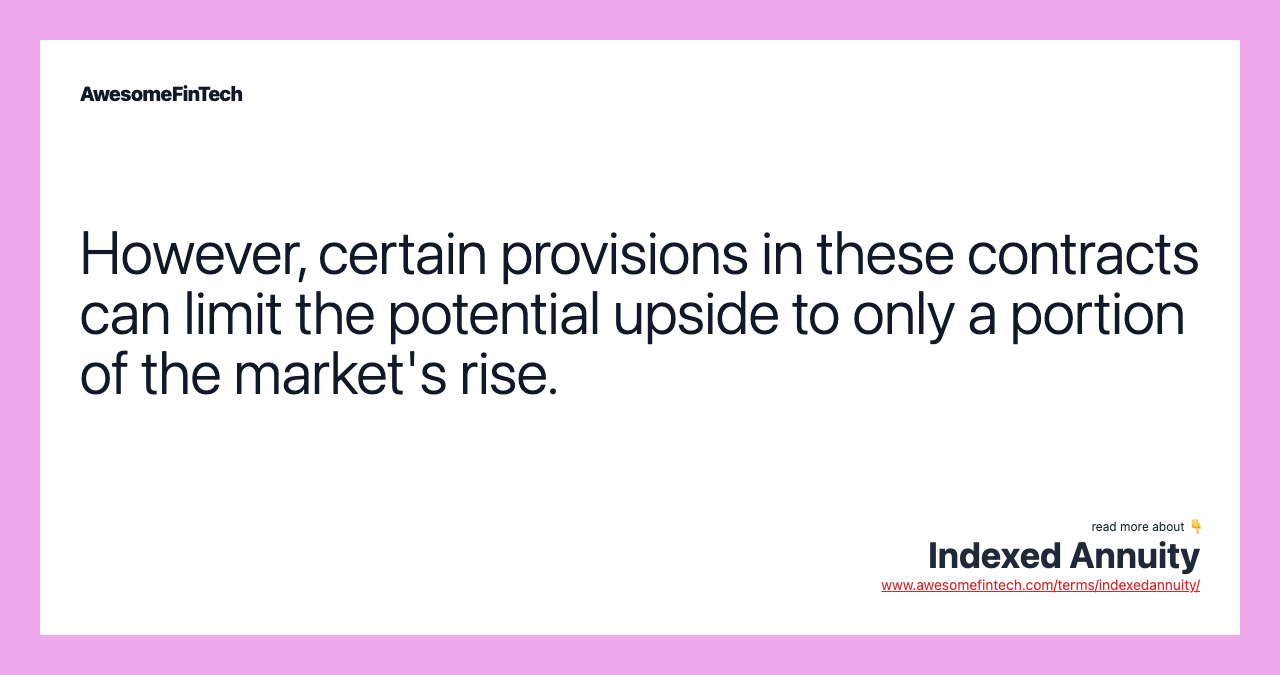Indexed Annuity
An indexed annuity is a type of annuity contract that pays an interest rate based on the performance of a specified market index, such as the S&P 500. It differs from fixed annuities, which pay a fixed rate of interest, and variable annuities, which base their interest rate on a portfolio of securities chosen by the annuity owner. Many indexed annuities offer a high participation rate for the first year or two, after which the rate adjusts downward. An indexed annuity is a type of annuity contract that pays an interest rate based on the performance of a specified market index, such as the S&P 500. The rate on an indexed annuity is calculated based on the year-over-year gain in the index or its average monthly gain over a 12-month period.

What Is an Indexed Annuity?
An indexed annuity is a type of annuity contract that pays an interest rate based on the performance of a specified market index, such as the S&P 500. It differs from fixed annuities, which pay a fixed rate of interest, and variable annuities, which base their interest rate on a portfolio of securities chosen by the annuity owner. Indexed annuities are sometimes referred to as equity-indexed or fixed-indexed annuities.



How Indexed Annuities Work
Indexed annuities offer their owners, or annuitants, the opportunity to earn higher yields than fixed annuities when the financial markets perform well. Typically, they also provide some protection against market declines.
The rate on an indexed annuity is calculated based on the year-over-year gain in the index or its average monthly gain over a 12-month period.
While indexed annuities are linked to the performance of a specific index, the annuitant won't necessarily reap the full benefit of any rise in that index. One reason is that indexed annuities often set limits on the potential gain at a certain percentage, commonly referred to as the "participation rate." The participation rate can be as high as 100%, meaning the account is credited with all of the gain, or as low as 25%. Most indexed annuities offer a participation rate between 80% and 90% — at least in the early years of the contract.
If the stock index gained 15%, for example, an 80% participation rate translates to a credited yield of 12%. Many indexed annuities offer a high participation rate for the first year or two, after which the rate adjusts downward.
Yields and rate caps
Most indexed annuity contracts also include a yield or rate cap that can further limit the amount that's credited to the accumulation account. A 7% rate cap, for example, limits the credited yield to 7% no matter how much the stock index has gained. Rate caps typically range from a high of 15% to as low as 4% and are subject to change.
In the example above, the 15% gain reduced by an 80% participation rate to 12% would be further reduced to 7% if the annuity contract specifies a 7% rate cap.
If you're shopping for an indexed annuity, ask about its "participation rate" and rate caps. Both can reduce your potential gains from any rise in the markets.
In years when the stock index declines, the insurance company credits the account with a minimum rate of return. A typical minimum rate guarantee is about 2%. Some can be as low as 0% or as high as 3%.
Adjusted values
At specific intervals, the insurer will adjust the value of the account to include any gain that occurred in that time frame. The principal, which the insurer guarantees, never declines in value unless the account owner takes a withdrawal. Insurers use several different methods to adjust the account's value, such as a year-over-year reset or a point-to-point reset, which incorporates two or more years' worth of returns.
As with other types of annuities, the owner can begin receiving regular income by annuitizing the contract and directing the insurer to start the payout phase.
Related terms:
Annuitant
An annuitant is an individual who is entitled to receive a periodic payment, or annuity. The recipient of a pension or an investor in an annuity may be an annuitant. read more
Annuity Table
An annuity table is a tool for determining the present value of an annuity or other structured series of payments. read more
Annuities: Insurance for Retirement
An annuity is a financial product that pays out a fixed stream of payments to an individual, primarily used as an income stream for retirees. read more
Annuity Contract
An annuity contract is a written agreement between an insurance company and a customer outlining each party's obligations in an annuity agreement. read more
Charitable Gift Annuity
A charitable gift annuity is an arrangement for a series of income payments for life, to be paid to an individual in return for a donation of assets. read more
Deferred Annuity
A deferred annuity is an insurance contract that promises to pay the buyer a regular stream of income, or a lump sum, at some date in the future. read more
Fixed Annuity
A fixed annuity is an insurance contract that pays a guaranteed rate of interest on the owner's contributions and later provides a guaranteed income. read more
Future Value of an Annuity
The future value of an annuity is the total value of a series of recurring payments at a specified date in the future. read more
Immediate Payment Annuity
An immediate payment annuity is a contract between an individual and an insurance company, providing a set amount of income immediately to the buyer. read more
Indexed Annuity
An indexed annuity is a type of annuity contract that pays an interest rate based on a specific market index, such as the S&P 500. read more